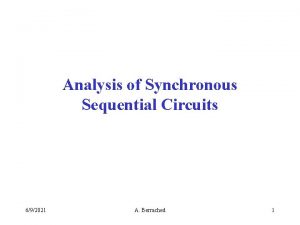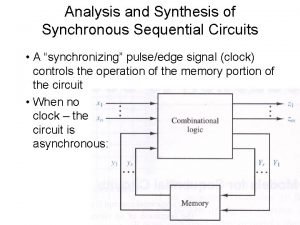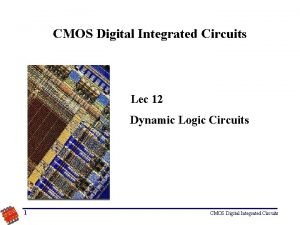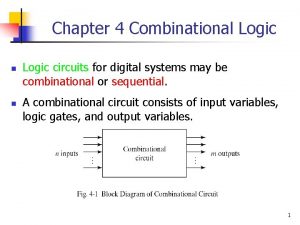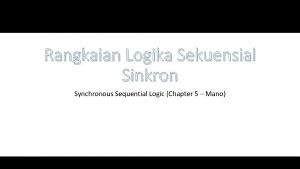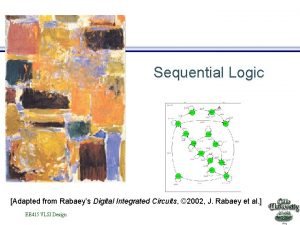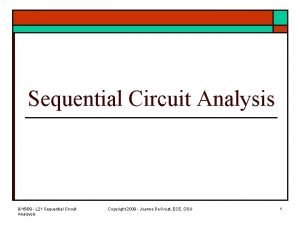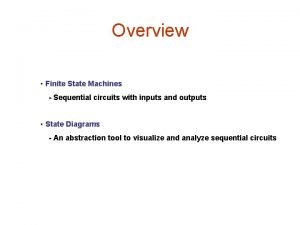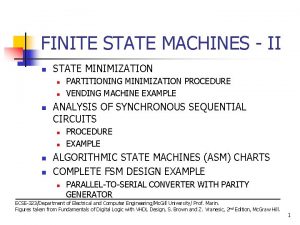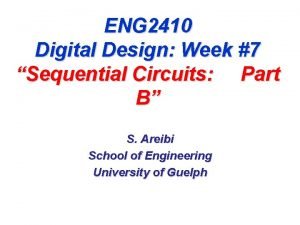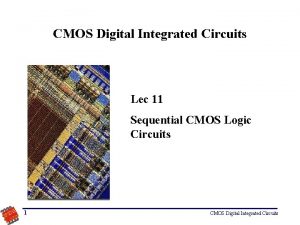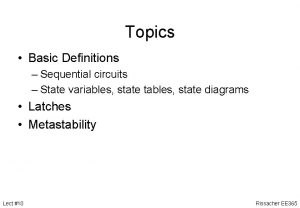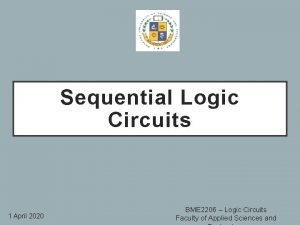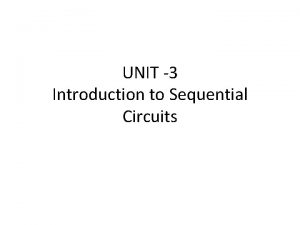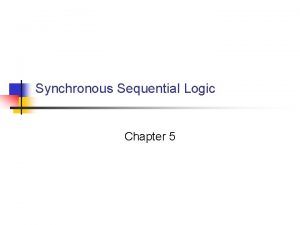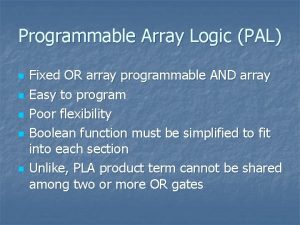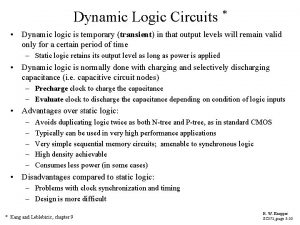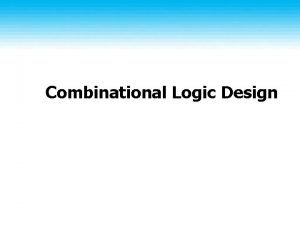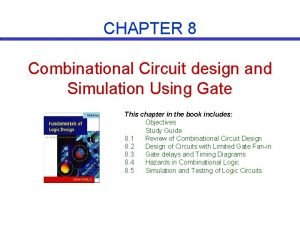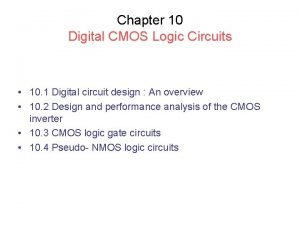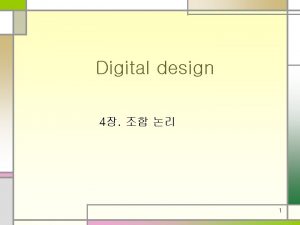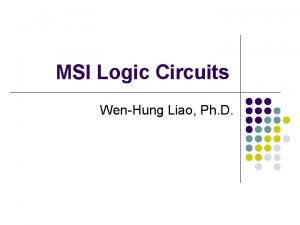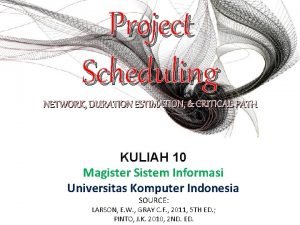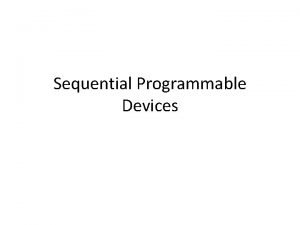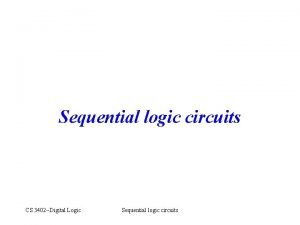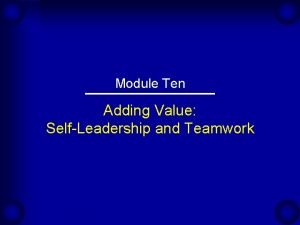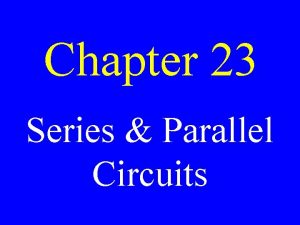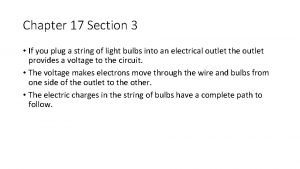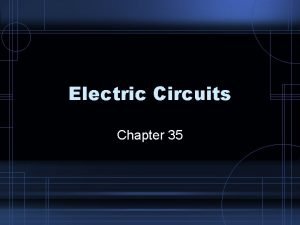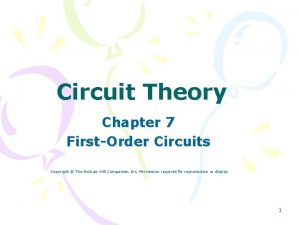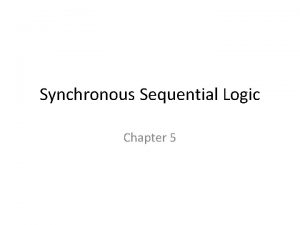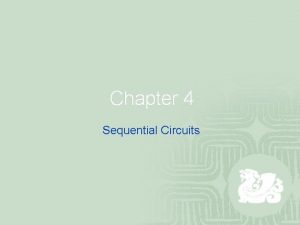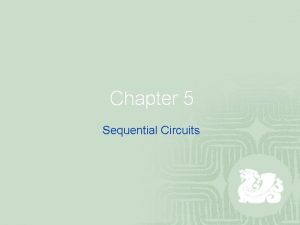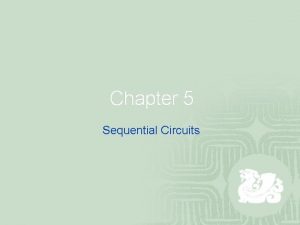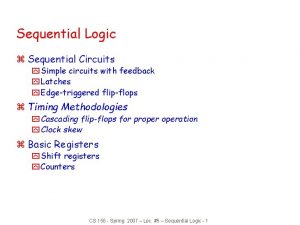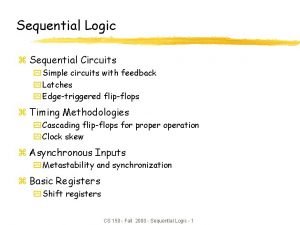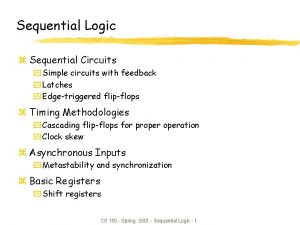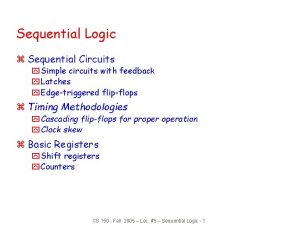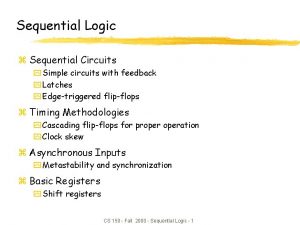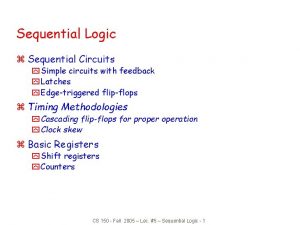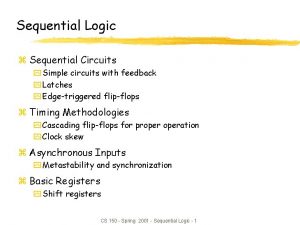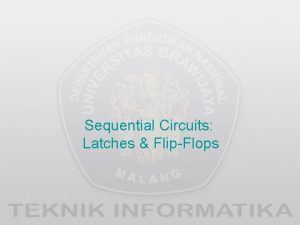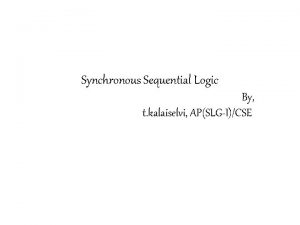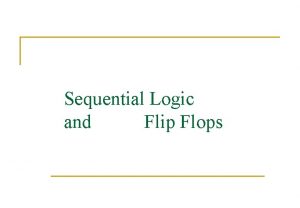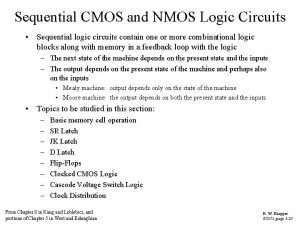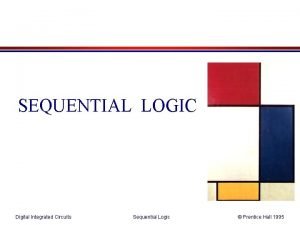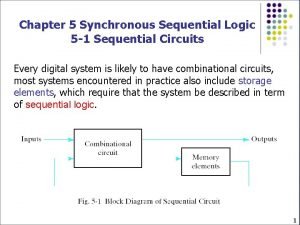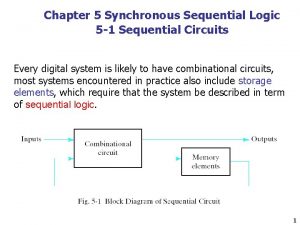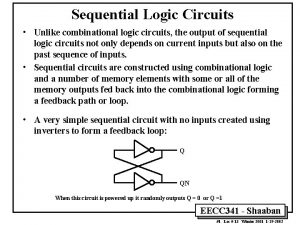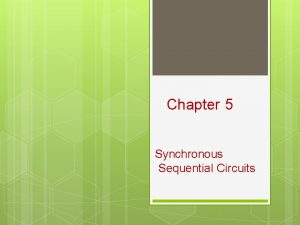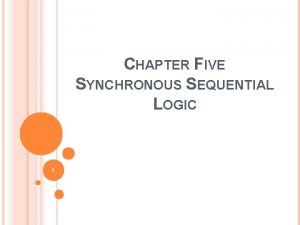CHAPTER FIVE SYNCHRONOUS SEQUENTIAL LOGIC 1 SEQUENTIAL CIRCUITS




























































- Slides: 60

CHAPTER FIVE SYNCHRONOUS SEQUENTIAL LOGIC 1

SEQUENTIAL CIRCUITS Asynchronous Inputs Combinational Circuit Outputs Memory Elements Synchronous Inputs Outputs Combinational Circuit Clock Flip-flops 2

LATCHES SR Latch (cross coupled NOR) 0 0 0 1 S R Q 0 0 Q 0 Q’ 1 Q = Q 0 Initial Value 3

LATCHES SR Latch S R Q 0 0 0 1 0 0 Q 0 1 Q’ 1 0 Q = Q 0 4

LATCHES SR Latch 1 0 0 1 S 0 0 0 R 0 0 1 Q 0 0 1 0 Q’ 1 0 1 Q = Q 0 Q=0 5

LATCHES SR Latch 1 1 0 0 S 0 0 R 0 0 1 1 Q 0 0 1 Q 0 1 0 0 Q’ 1 0 1 1 Q = Q 0 Q=0 6

LATCHES SR Latch 0 1 0 S 0 0 1 R 0 0 1 1 0 Q 0 0 1 0 Q 0 1 0 0 1 Q’ 1 0 1 1 0 Q = Q 0 Q=1 1 7

LATCHES SR Latch 0 1 1 S 0 0 1 1 R 0 0 1 1 0 0 Q 0 0 1 0 1 Q 0 1 0 0 1 1 Q’ 1 0 1 1 0 0 Q = Q 0 Q=1 Q=1 0 8

LATCHES SR Latch 1 1 0 S 0 0 1 1 1 R 0 0 1 1 0 0 1 Q 0 0 1 0 1 0 Q 0 1 0 0 1 1 0 Q’ 1 0 1 1 0 0 0 Q = Q 0 Q=1 Q = Q’ 10 9

LATCHES SR Latch 1 1 10 S 0 0 1 1 R 0 0 1 1 Q 0 0 1 0 1 Q 0 1 0 0 1 1 0 0 Q’ 1 0 1 1 0 0 Q = Q 0 Q=1 Q = Q’ 0 10

LATCHES SR Latch S R Q Q 0 0 0 1 1 0 1 S 0 0 1 1 Q R 0 Q=Q’=1 Invalid Set 1 1 Reset 0 0 Q 0 No change 1 No change 0 Reset 1 Set Q=Q’=0 Invalid 11

12

CONTROLLED LATCHES SR Latch with Control Input (operates with signal level) C S R 0 1 1 x 0 1 Q Q 0 0 1 Q=Q’ No change Reset Set Invalid 13

CONTROLLED LATCHES D Latch (Transparent Latch) Timing Diagram C D Q C D (data) 0 1 1 x 0 1 t Q Q 0 0 1 No change Reset Set Output may change 14

CONTROLLED LATCHES D Latch (D = Data) Timing Diagram C D Q C D 0 x 1 0 1 1 Q Q 0 0 1 No change Reset Set Output may change 15

FLIP-FLOPS Controlled latches are level-triggered C Flip-Flops are edge-triggered CLK Positive Edge CLK Negative Edge It operates with signal transitions 16

FLIP-FLOPS Master-Slave D Flip-Flop D D C D Latch (Master) Q D C D Latch (Slave) Master CLK Q Q Slave CLK D Looks like it is negative edge-triggered QMaster QSlave 17

FLIP-FLOPS Edge-Triggered D Flip-Flop D S R Q Q Positive Edge D Q Q Negative Edge 18

FLIP-FLOP CHARACTERISTIC EQUATIONS Analysis / Derivation J K Q Q J K Q(t) Q(t+1) 0 0 1 1 0 1 0 1 0 1 No change Reset Set Toggle 19

FLIP-FLOP CHARACTERISTIC EQUATIONS Analysis / Derivation J K Q Q J K Q(t) Q(t+1) 0 0 1 1 0 1 0 1 0 1 0 0 No change Reset Set Toggle 20

FLIP-FLOP CHARACTERISTIC EQUATIONS Analysis / Derivation J K Q Q J K Q(t) Q(t+1) 0 0 1 1 0 1 0 1 0 1 0 0 1 1 No change Reset Set Toggle 21

FLIP-FLOP CHARACTERISTIC EQUATIONS Analysis / Derivation J K Q Q J K Q(t) Q(t+1) 0 0 1 1 0 1 0 1 0 1 0 0 1 1 1 0 No change Reset Set Toggle 22

FLIP-FLOP CHARACTERISTIC EQUATIONS Analysis / Derivation J Q K Q J K Q(t) Q(t+1) 0 0 1 1 0 1 0 1 0 1 0 0 1 1 1 0 K 0 J 1 1 1 0 0 0 1 Q Q(t+1) = JQ’ + K’Q 23

FLIP-FLOPS JK Flip-Flop J Q K Q D = JQ’ + K’Q 24

FLIP-FLOPS T Flip-Flop T J Q K Q D = JQ’ + K’Q D = TQ’ + T’Q = T Q D T Q Q 25

FLIP-FLOP CHARACTERISTIC TABLES D Q Q J Q K Q T Q Q D 0 1 J 0 0 1 1 T 0 1 Q(t+1) 0 1 Reset Set K Q(t+1) 0 Q(t) 1 0 0 1 1 Q’(t) No change Reset Set Toggle Q(t+1) Q(t) Q’(t) No change Toggle 26

FLIP-FLOPS WITH DIRECT INPUTS Asynchronous Reset D Q R 0 D CLK Q(t+1) x x 0 Q R Reset 27

FLIP-FLOPS WITH DIRECT INPUTS Asynchronous Reset D Q Q R R 0 1 1 D CLK Q(t+1) x x 0 ↑ 0 0 ↑ 1 1 Reset 28

29

ANALYSIS OF CLOCKED SEQUENTIAL CIRCUITS The State = Values of all Flip-Flops Example AB=00 30

ANALYSIS OF CLOCKED SEQUENTIAL CIRCUITS Flip-Flop input equations DA = A(t) x(t)+B(t) x(t) =Ax+Bx DB = A’(t) x(t) = A’ x State equations A(t+1) = DA B(t+1) = DB Output equation y(t) = [A(t)+ B(t)] x’(t) = (A + B) x’ 31

ANALYSIS OF CLOCKED SEQUENTIAL CIRCUITS State Table (Transition Table) Present Input State A 0 0 1 1 B 0 0 1 1 t x 0 1 0 1 Next State A 0 0 0 1 0 1 t+1 B 0 1 0 0 Output y 0 0 1 0 1 0 t A(t+1) = A x + B x B(t+1) = A’ x y(t) = (A + B) x’ 32

ANALYSIS OF CLOCKED SEQUENTIAL CIRCUITS State Table (Transition Table) Present State A 0 0 1 1 t B 0 1 Next State Output x=0 x=1 A 0 0 B 0 0 A 0 1 1 1 t+1 B 1 1 0 0 y 0 1 1 1 y 0 0 t A(t+1) = A x + B x B(t+1) = A’ x y(t) = (A + B) x’ 33

ANALYSIS OF CLOCKED SEQUENTIAL CIRCUITS State Diagram Present State input/output AB 0/0 1/0 0/1 00 Next State x=0 Output x=1 x=0 x=1 A B A B y y 0 0 0 1 1 1 0 0 0 1 0 1 1 0 0 1 0 10 0/1 1/0 0/1 01 1/0 11 1/0 34

ANALYSIS OF CLOCKED SEQUENTIAL CIRCUITS D Flip-Flops Example: Present Input State A 0 0 1 1 x 0 0 1 1 y 0 1 0 1 Next State A 0 1 1 0 0 1 x y D Q CLK A Q A(t+1) = DA = A x y 01, 10 00, 11 0 1 00, 11 01, 10 35

ANALYSIS OF CLOCKED SEQUENTIAL CIRCUITS JK Flip-Flops Example: Present Next I/P State A B x A B Flip-Flop Inputs JA KA JB KB 0 0 1 0 0 0 1 0 1 1 1 0 0 1 1 0 0 1 1 1 0 0 0 1 1 1 1 1 0 0 0 JA = B JB = x’ KA = B x’ KB = A x A(t+1) = JA Q’A + K’A QA = A’B + AB’ + Ax B(t+1) = JB Q’B + K’B QB = B’x’ + ABx + A’Bx’ 36

ANALYSIS OF CLOCKED SEQUENTIAL CIRCUITS JK Flip-Flops Example: Present Next I/P State A B x A B Flip-Flop Inputs JA KA JB KB 0 0 1 0 0 0 1 0 1 1 1 0 0 1 1 0 0 1 1 1 0 0 0 1 1 1 1 1 0 0 0 1 11 00 0 0 01 0 10 1 1 37

ANALYSIS OF CLOCKED SEQUENTIAL CIRCUITS T Flip-Flops Example: Present Next F. F I/P O/P State Inputs A B x A B TA TB y 0 0 0 0 0 1 0 1 0 0 1 1 1 0 1 0 0 0 0 1 1 1 0 0 1 1 0 0 1 1 1 TA = B x y =AB TB = x A(t+1) = TA Q’A + T’A QA = AB’ + Ax’ + A’Bx B(t+1) = TB Q’B + T’B QB =x B 38

ANALYSIS OF CLOCKED SEQUENTIAL CIRCUITS T Flip-Flops Example: Present Next F. F I/P O/P State Inputs A B x A B TA TB y 0 0 0 0 0 1 0 1 0 0 1 1 1 0 1 0 0 0 0 1 1 1 0 0 1 1 0 0 1 1 1 0/0 00 1/0 01 1/1 0/1 1/0 11 10 1/0 0/0 39

THE PROBLEMS: 5. 3, 5. 4, 5. 6 5. 7, 5. 9, 5. 10, 5. 11 40

STATE REDUCTION AND ASSIGNMENT State Reductions on the number of flip-flops and the number of gates. A reduction in the number of states result in a reduction in the number of flip-flops. The external inputs and outputs requirements do not change. Start with state diagram shown in Fig. 5. 25. 41 Fig. 5. 25 State diagram

STATE REDUCTION State: a a b c d e f f g a Input: 0 1 0 1 1 0 0 Output: 0 0 0 1 1 0 0 Only the input-output sequences are important. Two circuits are equivalent Have identical outputs for all input sequences; The number of states is not important. Fig. 5. 25 State diagram 42

Equivalent states Two states are said to be equivalent For each member of the set of inputs, they give exactly the same output and send the circuit to the same state or to an equivalent state. One of them can be removed. 43

Reducing the state table e = g (remove g); d = f (remove f); 44

The reduced finite state problem State: a a b c d e d e a Input: 0 1 0 1 1 0 0 Output: 0 0 0 1 1 0 0 45

46

STATE ASSIGNMENT To design a sequential circuit, it is necessary to assign unique coded binary values to the states. Three possible binary state assignments. (m states need n-bits, where 2 n >= m). Unused states are treated as don’t-care conditions during the design. 47

Any binary number assignment is satisfactory as long as each state is assigned a unique number. 48

DESIGN PROCEDURE Design Procedure for sequential circuit The word description of the circuit behavior to get a state diagram; State reduction if necessary; Assign binary values to the states; Obtain the binary-coded state table; Choose the type of flip-flops; Derive the simplified flip-flop input equations and output equations; Draw the logic diagram; 49

DESIGN OF CLOCKED SEQUENTIAL CIRCUITS Example: (Sequence Detector) Detect 3 or more consecutive 1’s in a string of bits coming through an input line 1 0 S 0 / 0 S 1 / 0 0 0 S 3 / 1 1 1 0 S 2 / 0 1 State A B S 0 0 0 S 1 0 1 S 2 1 0 S 3 1 1

DESIGN OF CLOCKED SEQUENTIAL CIRCUITS Example: Detect 3 or more consecutive 1’s Present Input State A 0 0 1 1 B 0 0 1 1 x 0 1 0 1 Next State A 0 0 0 1 0 1 B 0 1 0 0 0 1 Output y 0 0 0 1 1 1/0 0/0 S 1 0/0 0/1 S 3 1/1 1/0 0/0 S 2 1/0

DESIGN OF CLOCKED SEQUENTIAL CIRCUITS Example: Detect 3 or more consecutive 1’s Present Input State A 0 0 1 1 B 0 0 1 1 x 0 1 0 1 Next State A 0 0 0 1 0 1 B 0 1 0 0 0 1 Output y 0 0 0 1 1 Synthesis using D Flip-Flops A(t+1) = DA (A, B, x) = ∑ (3, 5, 7) B(t+1) = DB (A, B, x) = ∑ (1, 5, 7) y (A, B, x) = ∑ (6, 7)

DESIGN OF CLOCKED SEQUENTIAL CIRCUITS WITH D F. F. Example: Detect 3 or more consecutive 1’s Synthesis using D Flip-Flops DA (A, B, x) = ∑ (3, 5, 7) =Ax+Bx DB (A, B, x) = ∑ (1, 5, 7) = A x + B’ x y (A, B, x) = ∑ (6, 7) =AB B 0 0 1 0 A 0 1 1 0 x B 0 1 0 0 B 0 0 A 0 0 1 1 x A 0 1 1 0 x

DESIGN OF CLOCKED SEQUENTIAL CIRCUITS WITH D F. F. Example: Detect 3 or more consecutive 1’s Synthesis using D Flip-Flops DA = A x + B x DB = A x + B’ x y =AB

FLIP-FLOP EXCITATION TABLES Present Next State Q(t) Q(t+1) 0 0 0 1 1 F. F. Input D 0 1 Present Next State F. F. Input Q(t) Q(t+1) J K 0 x 0 0 1 x 0 1 1 0 x 1 1 1 x 0 Q(t) Q(t+1) 0 0 0 1 1 T 0 1 1 0 0 0 (No change) 0 1 (Reset) 1 0 (Set) 1 1 (Toggle) 0 1 (Reset) 1 1 (Toggle) 0 0 (No change) 1 0 (Set)

DESIGN OF CLOCKED SEQUENTIAL CIRCUITS WITH JK F. F. Example: Detect 3 or more consecutive 1’s Present Input State A 0 0 1 1 B 0 0 1 1 x 0 1 0 1 Next State A 0 0 0 1 0 1 B JA 0 0 1 0 x 1 x Flip-Flop Inputs KA x x 1 0 JB KB 0 x 1 x 1 0 x 1 x 0 Synthesis using JK F. F. JA (A, B, x) = ∑ (3) KA (A, B, x) = ∑ (4, 6) JB (A, B, x) = ∑ (1, 5) KB (A, B, x) = ∑ (2, 3, 6)

DESIGN OF CLOCKED SEQUENTIAL CIRCUITS WITH JK F. F. Example: Detect 3 or more consecutive 1’s Synthesis using JK Flip-Flops JA = B x JB = x KA = x’ KB = A’ + x’ B B 0 0 1 0 x x A x x x B 0 1 x x A 1 0 0 1 x B x x 1 1 A 0 1 x x x A x x 0 1 x

DESIGN OF CLOCKED SEQUENTIAL CIRCUITS WITH T F. F. Example: Detect 3 or more consecutive 1’s Present Input State A 0 0 1 1 B 0 0 1 1 x 0 1 0 1 Next State A 0 0 0 1 0 1 B 0 1 0 0 0 1 F. F. Input TA 0 0 0 1 1 0 TB 0 1 1 1 0 Synthesis using T Flip-Flops TA (A, B, x) = ∑ (3, 4, 6) TB (A, B, x) = ∑ (1, 2, 3, 5, 6)

DESIGN OF CLOCKED SEQUENTIAL CIRCUITS WITH T F. F. Example: Detect 3 or more consecutive 1’s Synthesis using T Flip-Flops TA = A x’ + A’ B x TB = A’ B + B x B B 0 0 1 1 1 A 1 0 0 1 x A 0 1 x

The problems are: 5. 12, 5. 13, 5. 14, 5. 15, 5. 16, 5. 18, 60
 Contoh rangkaian sekuensial
Contoh rangkaian sekuensial Analysis of synchronous sequential circuits
Analysis of synchronous sequential circuits Synthesis of synchronous sequential circuits
Synthesis of synchronous sequential circuits Combinational logic vs sequential logic
Combinational logic vs sequential logic Software project wbs example
Software project wbs example Combinational logic sequential logic
Combinational logic sequential logic Combinational logic sequential logic 차이
Combinational logic sequential logic 차이 If x = 0 and y = 1, which output line is enabled?
If x = 0 and y = 1, which output line is enabled? Tspc d flip flop
Tspc d flip flop Chapter 4 combinational logic circuits
Chapter 4 combinational logic circuits Jelaskan pengertian dari synchronous sequential system
Jelaskan pengertian dari synchronous sequential system Advantages of parallel circuit over series circuit
Advantages of parallel circuit over series circuit Non bistable sequential circuits
Non bistable sequential circuits Sequential circuit analysis
Sequential circuit analysis Finite state machine sequential circuits
Finite state machine sequential circuits Vending machine asm chart
Vending machine asm chart Analysis of sequential circuits
Analysis of sequential circuits Non bistable sequential circuits
Non bistable sequential circuits Sequential circuits prelude
Sequential circuits prelude Sequential circuits
Sequential circuits State diagram
State diagram Sequential
Sequential Mealy and moore sequential circuits
Mealy and moore sequential circuits State diagram of jk flip flop
State diagram of jk flip flop Programmable array logic circuit
Programmable array logic circuit Cascading problem in dynamic cmos logic
Cascading problem in dynamic cmos logic Combinational logic circuits
Combinational logic circuits Simulation and testing of logic circuits
Simulation and testing of logic circuits Nmos inverter
Nmos inverter Combinational logic circuits lab report
Combinational logic circuits lab report Minecraft logic circuits
Minecraft logic circuits Binary systems and logic circuits
Binary systems and logic circuits Binary systems and logic circuits
Binary systems and logic circuits Bcd subtractor
Bcd subtractor Msi logic
Msi logic Duration estimation
Duration estimation What is a nonserual sequential logic in project
What is a nonserual sequential logic in project Combinational logic devices
Combinational logic devices S r q logic
S r q logic First order logic vs propositional logic
First order logic vs propositional logic First order logic vs propositional logic
First order logic vs propositional logic Third order logic
Third order logic Tw
Tw Five sequential stages of self-leadership
Five sequential stages of self-leadership And now with gleams of half-extinguished thought
And now with gleams of half-extinguished thought Five of five
Five of five 5 elements and 5 senses
5 elements and 5 senses Macbeth act five scene five
Macbeth act five scene five Fundamentals of electric circuits chapter 4 solutions
Fundamentals of electric circuits chapter 4 solutions Electric current
Electric current Chapter 35 electric circuits
Chapter 35 electric circuits Chapter 23 series and parallel circuits answers
Chapter 23 series and parallel circuits answers Chapter 20 electric circuits
Chapter 20 electric circuits Chapter 17 section 3 circuits answer key
Chapter 17 section 3 circuits answer key The circuit chapter 9
The circuit chapter 9 Fundamentals of electric circuits chapter 7 solutions
Fundamentals of electric circuits chapter 7 solutions Chapter 35 electric circuits answers
Chapter 35 electric circuits answers Ohm's law and electric power worksheet answers
Ohm's law and electric power worksheet answers Chapter 35 electric circuits
Chapter 35 electric circuits Chapter 7 first-order circuits
Chapter 7 first-order circuits Pony motor starting synchronous motor
Pony motor starting synchronous motor

